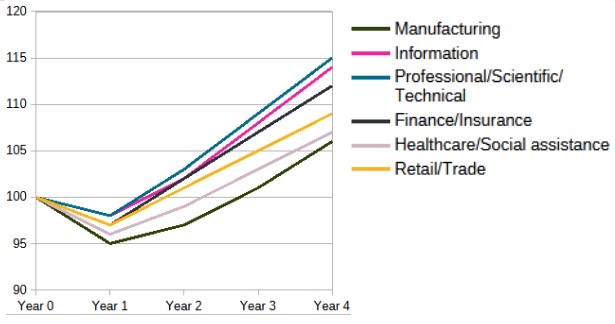If you were to read the news about Artificial Intelligence and see the headlines about Nvidia becoming the richest business in the world, Open AI turning over billions of dollars, individuals using AI to gain huge passive incomes … you might start believing the hype that AI can almost instantly revolutionise your business and, before too long, you’ll just be watching the money roll in.
I’m a small business owner who wants to leverage AI myself, so what’s the deal? Are we all going to be replaced … or enhanced? Let’s find out.
How Do AIs Search For Answers?
If you’ve been keeping up with the tech news, you might want to skip this paragraph, but a lot of business owners are still at the starting line trying to understand what AI can do. Artificial intelligence is a system that does things in a human-like way. We’ve all used Google search and learned to change full sentences into keywords to get the information we were looking for.
Then Chat-GPT came along and we could just start to type in (or say) a question and, a few seconds later, the answer wasn’t a list of new Internetty links to choose from, but a paragraph of human-sounding text explaining what the answer was. Jaw successfully dropped.
In only a couple of years, we’ve learned that a lot of those answers have been plucked out with some, but not much discernment, from the largest library in the world, the World Wide Web. How do they sound so human? It’s all due to LLMs (that’s Large Language Models) – a huge memory bank of millions of real sentences, all broken down into pieces and their probabilities of occurrence all notched into percentages.
Now, when you ask, ‘What is the capital of France?’ – just imagine all the books, films, blogs, poems etc. etc. which have referenced the answer … Paris. So the words ‘France’, ‘Paris’ and ‘capital’ have a super-strong percentage chance of occuring together. The LLM looks at that very high percentage and tells you, very confidently, and with increasingly more life-like phrasing, what the result of it’s comparisons is. Adoption of this amazing new technology has been rapid and, perhaps because it sounds so human, many people have started asking AI models for advice – 53% of UK small business owners are using Chat-GPT and its friends to help them guide business decisions. [1]
The Rise of Agentic AI
We are now moving from AI-search to AI-Agents, who perform a series of instructions for you based on the training you’ve given them. In some cases, these AI Agents can even make decisions on your behalf. Albania has recently appointed an AI government minister to handle public government contracts and has executive decision-making powers. [2]. On the horizon? AI Agents built into your Internet browser that can view your history and all your personal files, decide on your preferences, and buy or organise things it knows you like. And beyond that? The Agentic Web – Agents working together without any human involvement, comparing the data they have collected and coming to mutually favourable decisions [3].

So, should a small-medium size business be investing in this future? I mean, beyond the casual use of Chat-GPT, Co-Pilot or (for the dabblers) Claude. Is AI the game changer?
One Statistic That Speaks Volumes
Are you ready for the statistic MIT came up with in July this year to headline their study of Generative AI adoption’s Executive Summary [1]?
Despite $30–40 billion in enterprise investment into GenAI, this report uncovers a surprising result in that 95% of organizations are getting zero return.
This shocked me. That is a lot of money which, at least in the opinion of the researchers, had not led to the expected revenues that AI was meant to unlock.
So, some caution is in order here. If we think about it … not everyone needs a power drill. Now, if you need a drill, then you should absolutely invest in a power drill. AI is a powerful tool for repetitive, easily-supervised, non-risk business tasks. It is very much taking away junior roles in software-driven business sectors and, unemployment and related mental illness consequences aside, it makes sense that the kind of jobs a junior staffer would be given are the kind of jobs AI feeds off.
AI adoption and the J-Curve
Initial adoption of AI business solutions leads to a shift in the way a business works and consequent re-training, legacy program integration and all the related costs of building new efficiencies in. This means that businesses adopting AI in a big way see an initial drop in profits. The numbers show businesses taking 18 months or more to start seeing any financial benefits (between 2017 and 2021). [4] However, by the end of the 4 year period, early adopters had begun to outperform their non-adopting competition.
“AI isn’t plug-and-play,” saysKristina McElheran, one of the authors of a paper on the rise of AI in the US, “It requires systemic change, and that process introduces friction, particularly for established firms.”

Sources: AI generated. Sector comparisons are based on 1) how widely different industries are using AI and 2) how advanced they are digitally, from official U.S. business surveys (BTOS and ABS) and insights from multiple other studies (census.gov, federalreserve.gov, apps.bea.gov).
Larger and/or more digitally mature businesses were better placed to get the advantage earlier. Complementary business functions needed parallel investment, such as data infrastructure, training and designs of workflows to accommodate the change. Without them, bottlenecks can appear or AI fails to deliver at the expected rates. Older organisations with legacy systems and very established routines also took longer to see the benefits. So, the more tech-adjusted you already are, the more nimble you are, the more likely AI can boost your company’s activity.
“AI isn’t just plug and play”
One corporate lawyer from a medium-sized firm noted that a $20/month ChatGPT subscription consistently produced better outputs than her firm’s $50,000 specialised tool. She noted:
“Our purchased AI tool provided rigid summaries with limited customization options. With ChatGPT, I can guide the conversation and iterate until I get exactly what I need. The fundamental quality difference is noticeable, ChatGPT consistently produces better outputs, even though our vendor claims to use the same underlying technology.” [3]
Security
If you are planning to invest in building your own AI solution, the model will need constant updates and maintenance, and the responsibility for security is all on your shoulders. The less human supervision a system has, especially if Agentic AI is used, the integral design of an LLM means that, without intervention, it sees your initial instructions and any other data it comes across with equal value.
Here’s part of a discussion about how LLMs work. Note the italics added by me:
“The difference is that LLMs are fundamentally insecure in this way as part of their basic design … this programming language deliberately executes values stored in the String type sometimes, depending on what’s inside it. And we don’t really understand how it makes that choice, but we do know that String values that ask the language to execute them are more likely to be executed. And this is fundamental to the language, as the only way to make any code execute is to put it into a String and hope the language chooses to run it.” [5]

In this grave new world, bad actors could plant secret commands (string type = text instructions) inside otherwise inoffensive website content. Your AI Agent crawls that data and asks you if you want to take a benign action e.g. ‘Summarise findings’, and then actions it.
What Can AI Do For SMEs?
Consider what tasks your business would like to enhance and the risk-reward profile:
- Could an off-the-shelf tool handle this for you? (see below for examples)
- Are you looking to combine multiple systems into more automated workflows?
- Is it something currently controlled by a human but with large financial or compliance risks attached?
If the answer is yes, seek the advice of an AI architect or consultant who can check how viable an AI system is. Or, join an Accelerator programme for SMEs, where expertise is more readily available (see below for examples).
Off-the-shelf solutions
UK AI Innovation Opportunities
Keep an Eye on the Dials
It goes without saying, but monitor your ROI and KPIs to ensure you know what benefits you’re getting. Appoint a champion who will explain the reasons and benefits to staff, of whom many are probably skeptical of AI more generally. On the opposite side of the aisle, some may be overconfident in their trust of automated systems. A pilot project involving a few voices from across the business might help with persuasion. Consider data risks especially and set out what the response should be in case data is compromised. Then, set the example and try to understand the technology yourself so that you can set a leading example in making use of it, and be among the first to notice any issues.
[1] What Does Worldpay Survey Say About UK SMEs’ Attitude to AI? | Business Chief North America
[2] Albania appoints world’s first AI-made minister – POLITICO
[3] State_of_AI_in_Business_2025_Report MIT NANDA Aditya Challapally Chris Pease Ramesh Raskar Pradyumna Chari July 2025
[4] The Rise of Industrial AI in America: Microfoundations of the Productivity J-Curve(s)
[5] Comet AI browser can get prompt injected from any site, drain your bank account | Hacker News


Leave a Reply